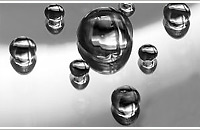|
|
|
|
|
|
 | Physico-chemical measurements: Humidity measurement:
Relative humidity sensors, that base on polymers
Because of the price, the relative humidity sensors, that base on polymers are most common. Depending on the type of the material, the polymer, that absorbs humidity changes its conductivity or dielectric constant. BResist sensors, that base on the measurement of the conductivity changes of the sensor prove a large dependence on the temperature. A complication level of the systems of capacity and resistance measurement isn't large and doesn't influence on the choice of interface of th eappliance. Doubtless advantage is large accuracy of the measurement (about 2%) and very little size of the sensor. Conductivity
The rules of the measurement The conductivity sensors that are applied in the low scope of the scale consist of two electrodes that are made of rust-proof steel or of titanium. A converter assures lability of the voltage that is given to the electrodes. A curent that flowes in the circuit depends only on the resistivity of the liquid between the electrodes. The resistivity is measured and characterized by the conductivity of the water. Choosing the elements of the measuring system, you should take measuring scope of the electrode into th eaccount. Each electodr has specified rate K, that is strongly connected with the scope. PH
Choosing the electrode you should take measuring pH scope and conductivity of measured medium into account. The rule of the measurement  A measurement of the pH rate bases on finding the difference of the potentials between two electrodes. The electrode of the reference assures direct contact between a sample and electrolyte. The measuring electrode is separated from the sample by the glass diaphragm, that is susceptible for H+ ions. A potencial difference between electrodes depends on the number of H+ ions, that are in the sample. The other way of finding pH rate is difference between the conductivity, that is measured in front of and at the back of stronly acidic cationic exchanger. A measurement of the pH rate bases on finding the difference of the potentials between two electrodes. The electrode of the reference assures direct contact between a sample and electrolyte. The measuring electrode is separated from the sample by the glass diaphragm, that is susceptible for H+ ions. A potencial difference between electrodes depends on the number of H+ ions, that are in the sample. The other way of finding pH rate is difference between the conductivity, that is measured in front of and at the back of stronly acidic cationic exchanger. Turbidity
Turbidity measurements base on the phenomenon of light dispersal Oxygene measurement
Circonium cells are characterized by a high stability and precision, reliabilty and mechanical resistance, little exploitation requirements, long motility, great vibration resistance, thermal shock resistance and by the resistance against reductive conditions and pollution of the electrodes (sulphur, vanadium and so on). The cell method is applied for exhaust gases analyzers anf for measurements of oxygene vestigal amount.
| Visit our websites: You can check our online Industrial Automation |

Dotacje na innowację. Projekt jest współfinansowany przez Unię Europejską ze środków
Europejskiego Funduszu Rozwoju Regionalnego
CASP System - Twój partner w dziedzinie Badań Nieniszczących i Automatyki Przemysłowej!

 Mapa
Mapa Napisz do nas
Napisz do nas



 Koszyk
Koszyk









 A circonium method of oxygene measurement bases on using the properties of circonium oxide, which by high temerature and by the difference of oxygene concentration creates an electrochemical cell and generates (pursuant to Nernst equation) electric tension.
A circonium method of oxygene measurement bases on using the properties of circonium oxide, which by high temerature and by the difference of oxygene concentration creates an electrochemical cell and generates (pursuant to Nernst equation) electric tension.






